Hoisin Sauce vs Oyster Sauce: What’s so different?
Hoisin sauce and oyster sauce are both popular condiments in Chinese cooking. And they may have a similar glossy appearance but are very different in taste. Let’s explore the major differences between hoisin sauce and oyster sauce.
Hoisin sauce and oyster sauce are both popular condiments in Asian cuisine. They have a thick consistency and a brown colour. But that is where the similarities end. They are very different in taste.
Oyster sauce is made from oyster extract, whereas the key ingredient in hoisin sauce is fermented soybean paste. Hoisin sauce is sweet with a fragrance of warm, toasted spices, whereas oyster sauce is salty with an ocean-like flavour.
You will find both sauces in the Asian aisle of the grocery store.
Keep reading for more information, including how to make oyster sauce or a vegan oyster sauce substitute from mushrooms. And the best hoisin sauce substitutes.
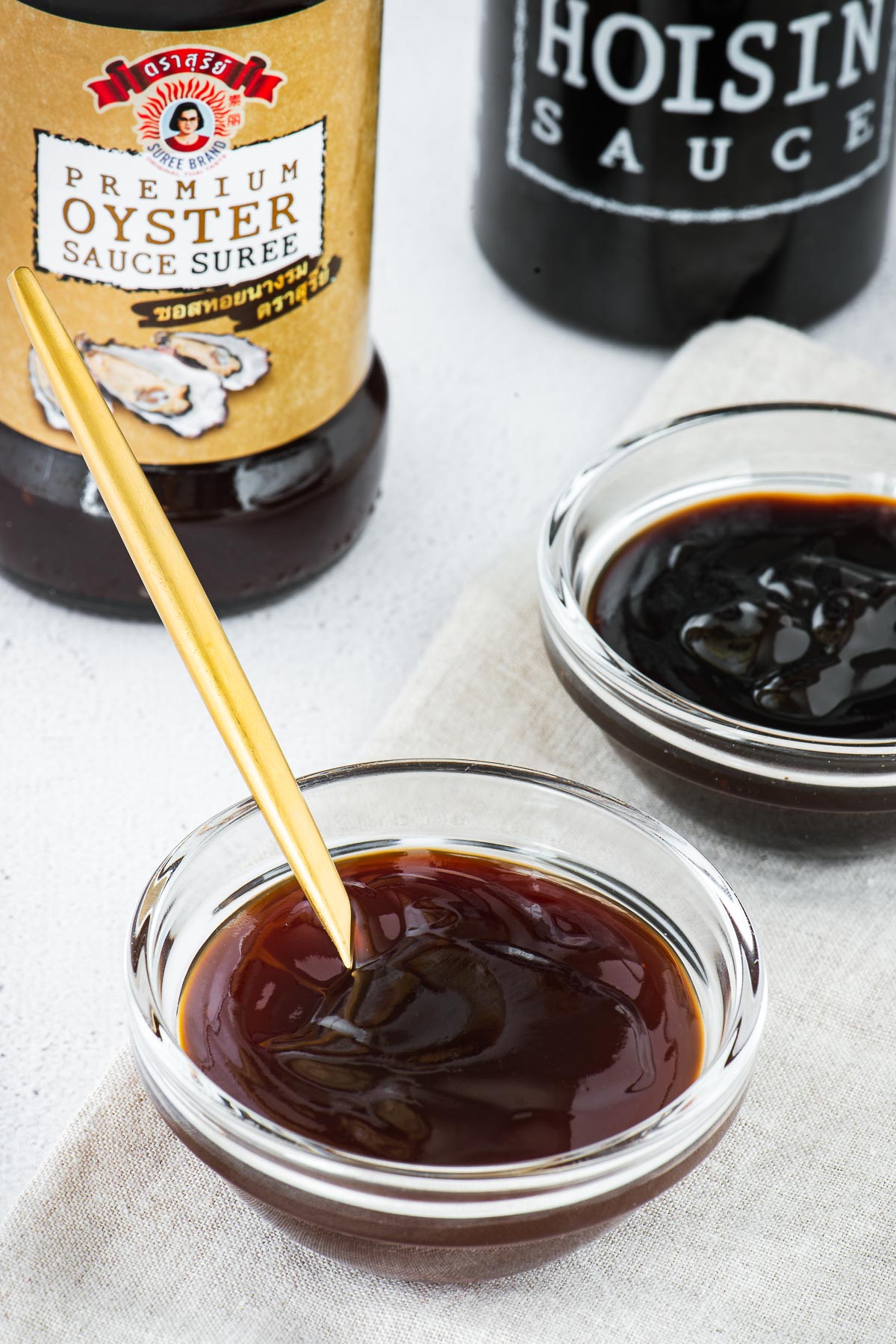
Hoisin sauce vs oyster sauce at a glance
| Hoisin Sauce | Oyster Sauce | |
| Key Ingredient | Fermented soybean paste | Oyster extract |
| Colour | Dark brown | Light reddish-brown |
| Texture | Thick and glossy sauce | Thick and glossy sauce |
| Flavour | Sweet with a fragrance of warm spices | Very salty with a slight ocean flavour |
| Vegan | Yes | No (ostrovegan only) |
| Gluten-free | No | Only sometimes |
What is hoisin sauce?
Hoisin is a thick, fragrant dark brown sauce with a reddish hue. It is a common ingredient in Chinese cuisine (Cantonese), as well as Vietnamese cuisine.
It is a versatile ingredient, sometimes used as a glaze for meat, as a stir-fry sauce or as a dipping sauce.
There are regional variations, but it typically contains soybeans, fennel, red chilli peppers, garlic, five-spice and vinegar.
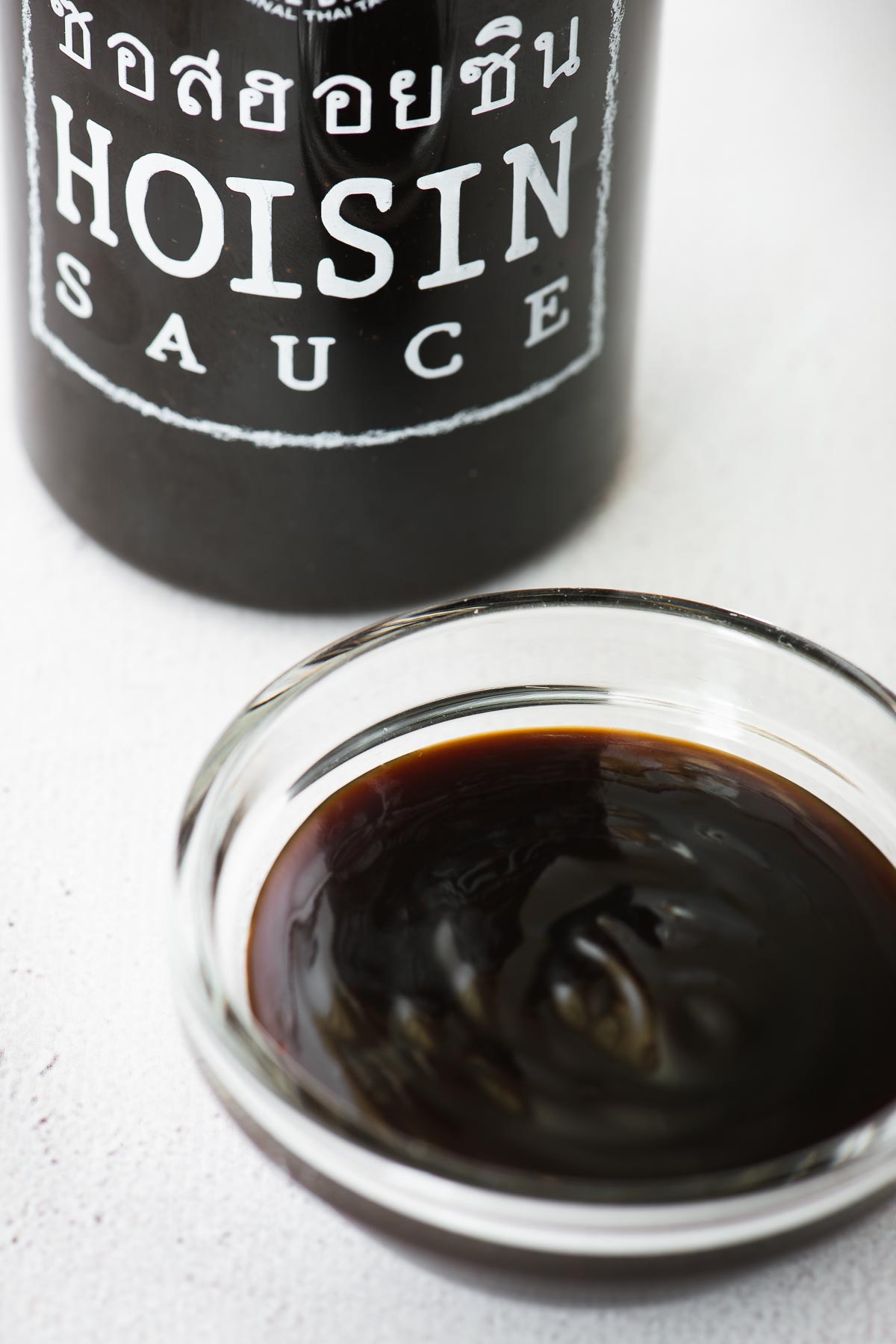
How is hoisin sauce used?
Hoisin sauce is an essential ingredient in many Asian dishes.
- It can be a marinade in meat dishes such as char siu or a glaze for broiled chicken and duck.
- It is a popular dipping sauce for rice noodle rolls, Peking duck pancakes and spring rolls.
- It is a typical ingredient in moo shu pork (pork and egg stir-fry).
- And it is served as a condiment for Vietnamese phở (Vietnamese noodle soup).
It is also an ingredient in Chinese barbecue sauce, and it is equally delicious in American barbecue sauce.
Try hoisin sauce in this super easy hoisin peanut dipping sauce for Vietnamese spring rolls!
Hoisin sauce ingredients
The key ingredient of hoisin sauce is fermented soybean paste.
But it can include other starches like sweet potato, wheat and rice. Further ingredients include water, sugar, soybeans, sesame seeds, white distilled vinegar, salt, garlic, red chilli peppers and sometimes preservatives or colouring agents.
What does hoisin sauce taste like?
Hoisin sauce is very sweet, a bit salty, and beautifully fragrant with warming notes of fennel, star anise and cinnamon. It is a smooth glossy sauce with a thick texture.
What is the best substitute for hoisin sauce?
The main ingredient of hoisin sauce is fermented bean paste. Use Chinese fermented bean sauce to create your own hoisin sauce at home. Or make a quick pantry staple substitute with peanut butter.
1. Make hoisin at home with black bean sauce
Add a third cup of brown sugar, three tablespoons of Chinese black bean paste, two tablespoons of all-purpose soy sauce, two tablespoons of water, and one tablespoon of rice vinegar to a saucepan. Simmer the mixture, and stir it often until the sugar dissolves.
Add half a teaspoon of Chinese five-spice powder and half a teaspoon of toasted sesame oil. And use a stick blender to blend until completely smooth.
Related Post: The best substitute for Chinese five-spice
2. Easy homemade substitute for hoisin sauce
You can make a quick hoisin sauce substitute (that happens to be vegan) at home by blending:
- half a cup of soy sauce,
- a quarter cup of peanut butter,
- a quarter cup of maple syrup (or brown sugar)
- one tablespoon of vinegar (rice vinegar or apple cider vinegar)
- one tablespoon sesame oil,
- one tablespoon minced garlic, and
- one teaspoon of Chinese five-spice.
3. Spiced sweet soy sauce
Another good substitute for hoisin sauce is sweet soy sauce (kecap manis or ketjap manis). Some varieties include garlic and star anise, giving a similar fragrance to hoisin sauce. It works even better if you stir in some bean paste, sesame oil and a pinch of Chinese five-spice.
Related Post: Make sweet soy sauce (kecap manis) with star anise for a hoisin sauce substitute.
Is hoisin sauce vegan?
Yes, hoisin sauce is vegan. The main ingredient in hoisin sauce is fermented soybean paste and it contains no animal products.
Is hoisin sauce gluten-free?
No, hoisin sauce is typically not gluten-free. Commercially produced hoisin sauce can include wheat flour as a thickening agent. It can also contain soy sauce which contains wheat.
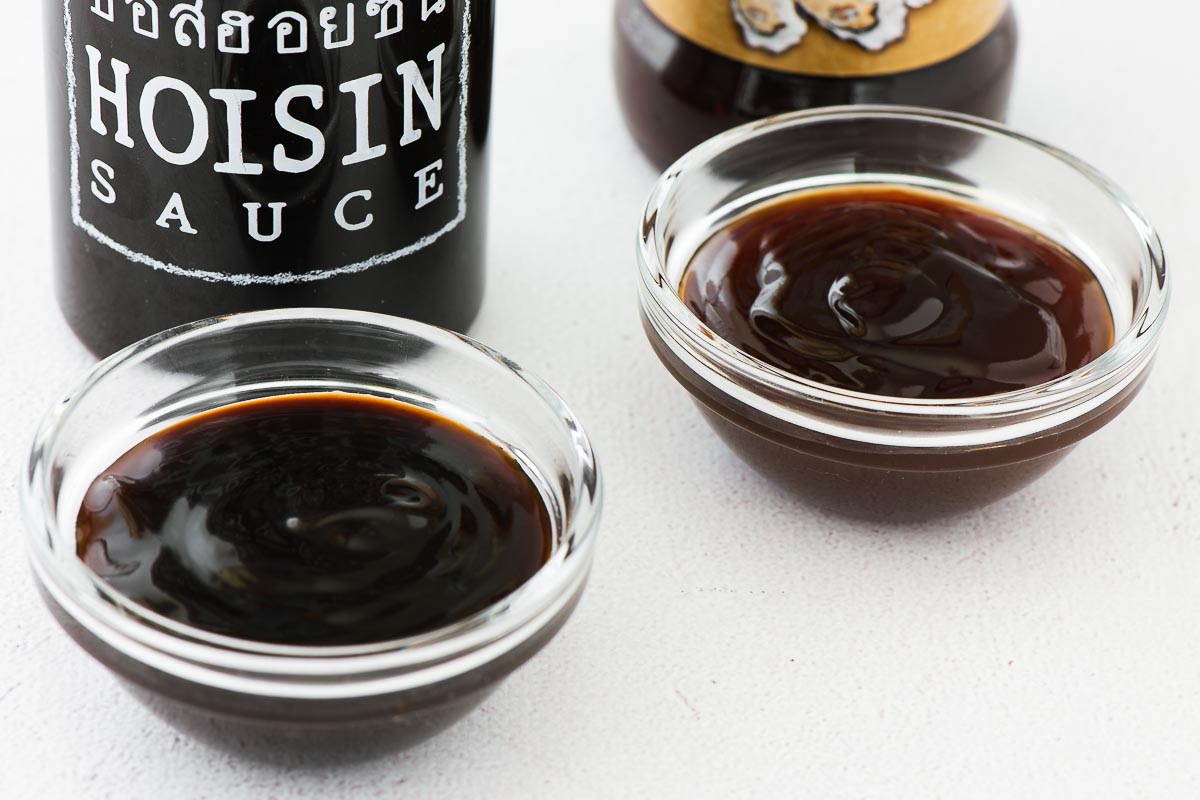
What is oyster sauce?
Real oyster sauce contains only oyster extract.
But, modern commercialised oyster sauce is a dark brown condiment made from oyster extracts, sugar, salt and water thickened with cornstarch (or wheat flour). It can also contain soy sauce and MSG.
Boiling oysters in water produce an oyster extract, a white, opaque broth. To make oyster sauce the oyster extract is reduced over heat until the liquid has a caramel-like brown colour with the desired viscosity.
In traditional oyster sauce, there is no need for preservatives, not even salt. The oysters provide a savoury flavour. But modern versions include additional ingredients and preservatives.
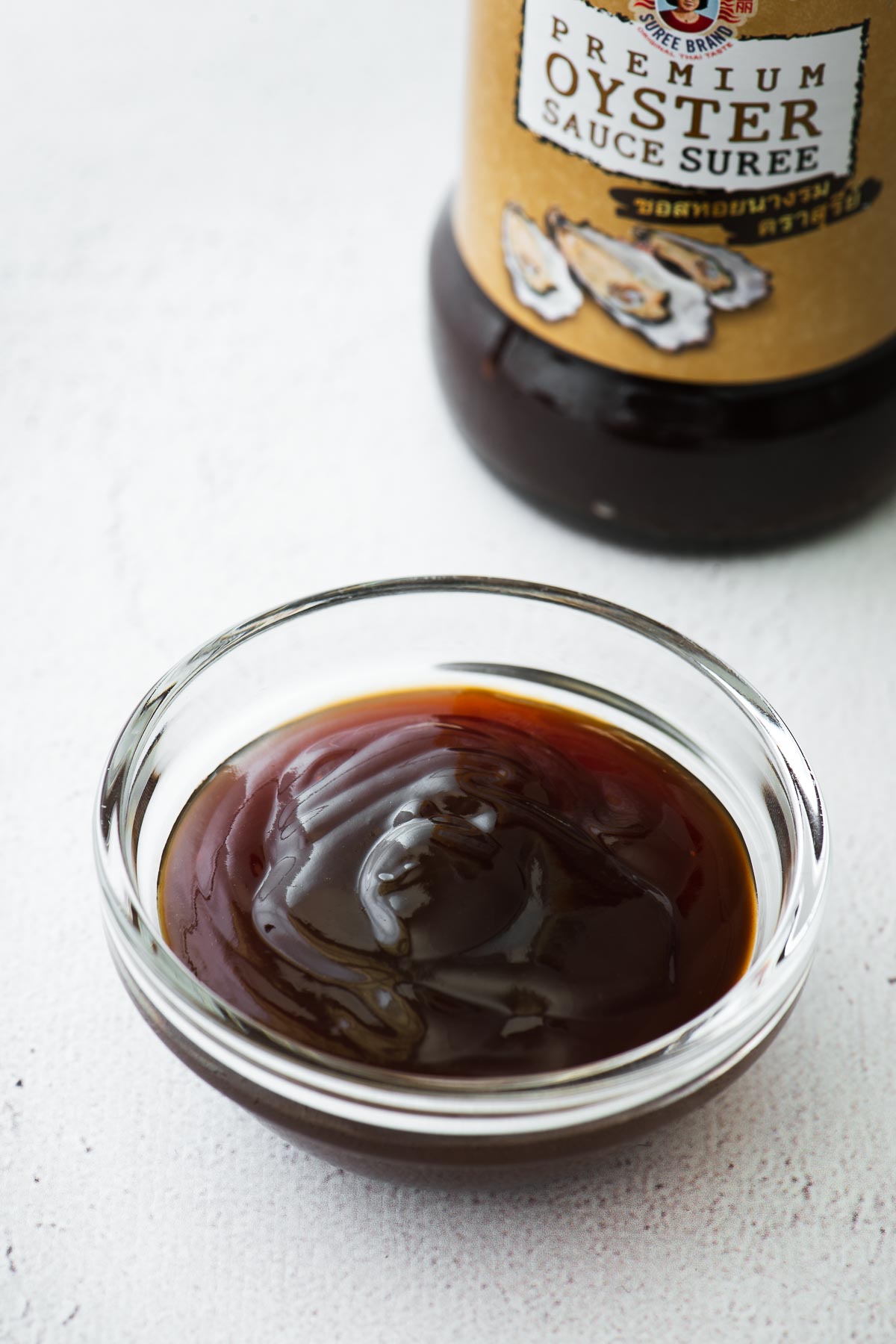
How is Oyster sauce used?
Oyster sauce is a staple in Chinese, Thai, Malay, Vietnamese, and Khmer cuisine.
- It is a common ingredient in noodle stir-fries, such as chow mein.
- Traditional Chinese chicken and mushroom clay pot rice (Bo Zai Fan) rely on the salty, umami flavour of oyster sauce.
- And it is popular in Chinese-American dishes, such as beef with oyster sauce (and stir-fried vegetables).
- Thai-style beef short ribs (Phat Sii Krong Neua) get a flavour boost with oyster sauce.
Try oyster sauce in this traditional Japanese okonomiyaki sauce.
Don’t confuse oyster sauce with fish sauce
Oyster sauce and fish sauce are very different. Fish sauce is a clear, watery, fermented fish brine, whereas oyster sauce is a thick, reduced oyster extract. Oyster sauce is significantly less fishy.
Oyster sauce ingredients
Traditional oyster sauce contains only oysters, oyster liquid and water. But, modern commercialised oyster sauce can contain oyster extracts, sugar, salt, water, cornstarch and MSG. It can also have soy sauce and wheat flour.
What does oyster sauce taste like?
Oyster sauce is very salty with an oyster-like taste of the ocean. It has a very slight sweetness, but not nearly as sweet as hoisin sauce.
What is the best substitute for oyster sauce?
Oyster sauce is very salty with that oyster-like taste of the ocean. There really is nothing out there that matches the taste completely. You can make your own oyster sauce with fresh oysters, or you can make a vegan oyster sauce option from shiitake mushrooms.
1. How to make oyster sauce
Shuck fresh oysters and reserve the oyster juices. Add the oysters to a food processor and blitz until finely chopped. Transfer the chopped oysters and the reserved oyster liquid to a small saucepan and bring it to a boil.
Reduce the heat and simmer, covered, for 10 minutes. If the mixture is dry, add a little bit of water.
Drain the oyster broth through a fine sieve and discard the bits of oysters. Add two tablespoons of light soy sauce for each half cup of oyster liquid.
Return it to the saucepan and simmer again for 10 minutes.
Allow the sauce to cool and refrigerate.
2. Vegan oyster sauce substitute with shiitake mushrooms
This is a great homemade vegan option with a delicious umami taste.
Soak five dried shiitake mushrooms in a cup of boiling water for 10 minutes until they are soft. Add the softened mushrooms and mushroom broth to a blender and blitz until smooth.
Place the mushroom sauce in a small saucepan. Add a teaspoon of brown sugar (or coconut sugar) and half a cup of light soy sauce (or all-purpose soy sauce, tamari or coconut aminos).
Mix one tablespoon of cornstarch with two tablespoons of cold water and stir the slurry into your mushroom sauce.
Simmer the sauce for a minute or two until it thickens a bit. It will continue to thicken as it cools.
Transfer to a clean jar, refrigerate and use it within two weeks.
3. More oyster sauce alternatives
Hoisin sauce is a good match for the texture of oyster sauce, but it has the warm fragrance of toasted spices like anise and cinnamon. And it has a sweet taste, compared to the salty taste of oyster sauce.
You can use the sweet, sometimes smoky teriyaki sauce as an oyster sauce substitute in meat glazes.
And while soy sauce does not have the same thick consistency as oyster sauce, it has a salty, umami flavour that makes it a suitable substitute for oyster sauce. Use light soy sauce, tamari or coconut aminos. You can thicken soy sauce by simmering it for a few minutes with a cornstarch slurry (cornstarch with cold water).
Is oyster sauce vegan?
It depends. Oyster sauce contains real oyster extract. But, some vegans (referred to as ostrovegan or bivalvegan) eat bivalves (oysters, mussels, and potentially clams and scallops). Therefore, oyster sauce is ostrovegan, but not vegan.
However, there are commercially produced vegan oyster sauce alternatives made from mushrooms.
Is oyster sauce gluten-free
No, modern oyster sauce is not guaranteed to be gluten-free. While traditional oyster sauce is gluten-free, modern commercial oyster sauce often contains soy sauce which can contain wheat.
So, it is best not to assume oyster sauce is gluten-free.
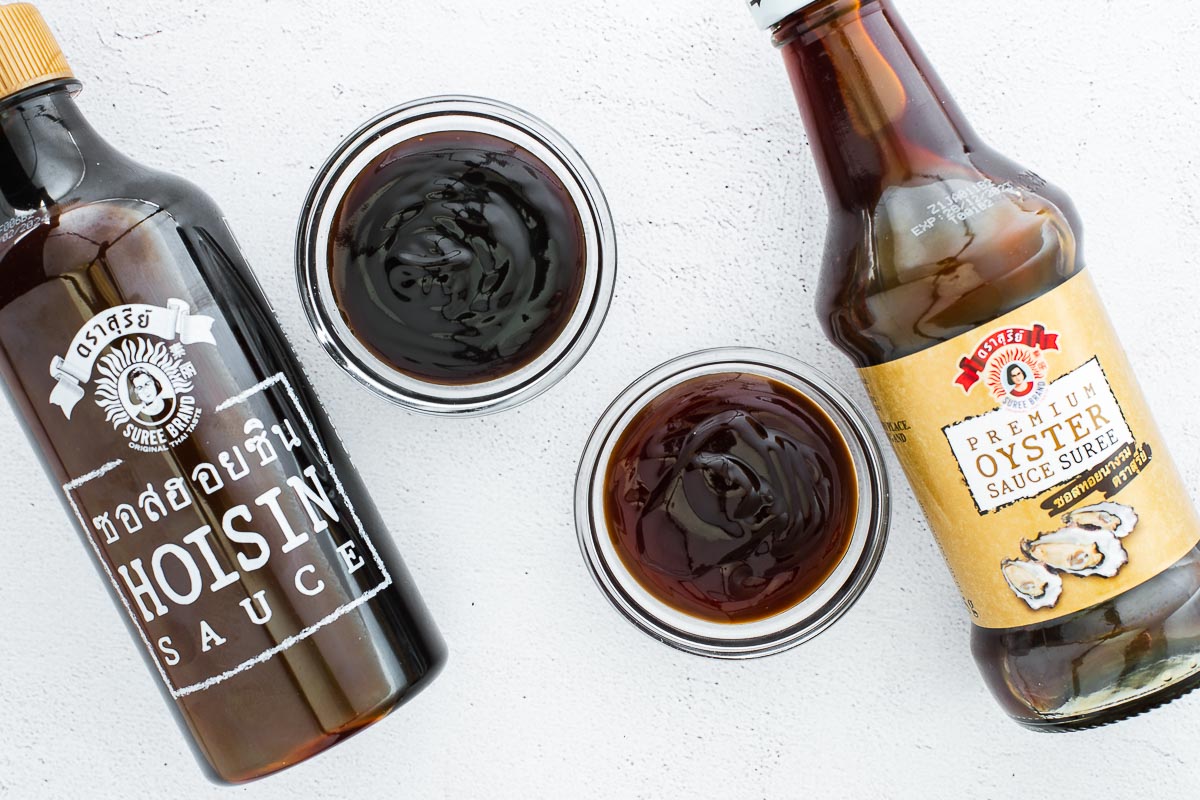
Hoisin sauce vs oyster sauce summary
Oyster sauce and hoisin sauce have a very similar texture and appearance. Hoisin is a dark brown sauce, and oyster sauce is more of a caramel reddish-brown colour.
The main difference lies in the taste due to the vastly different ingredients. Oyster sauce is made from oyster extract, whereas the key ingredient in hoisin sauce is fermented soybean paste.
Oyster sauce is very salty with a slight oceanic flavour, while hoisin sauce is much sweeter with a fragrance of warm spices.
Furthermore, oyster sauce is not vegan (though it is ostrovegan), while hoisin sauce is suitable for vegans. And neither sauce is guaranteed to be gluten-free.
Read more about my favourite Asian ingredients:
